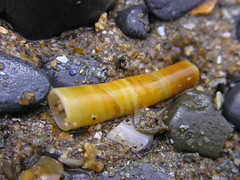
The fossil exposures of the Lincoln Creek Formation, southern Olympic Peninsula, near the town of Porter, Washington consist of tuffaceous siltstone and sandstone with concretionary beds throughout. They are slightly older than originally thought, coming in around 37 million-years, straddling the Eocene-Oligocene border. The site has produced several dozen different species of molluscs, including the elusive tusk shell, and is well known for crabs.
Here a wee modern tusk shell or scaphopod sits in the sand. The whitish aragonitic shells of scaphopods are conical and curved with a planispiral curve, looking a bit like an elephant's tusk, hence their common name. They prefer to live on soft substrates in subtidal zones so they are not as abundant or readily visible on our beaches as their gastropods and bivalves compatriots. Tusk shells and their fossil relatives, however, are found commonly in the sediments at Porter and other localities throughout the Pacific Northwest.





Comments